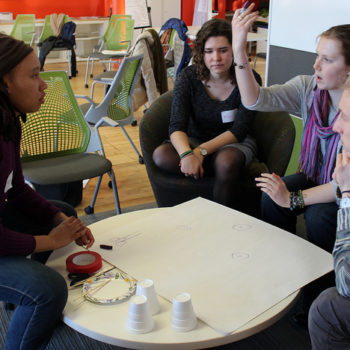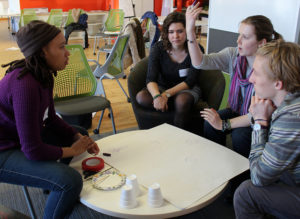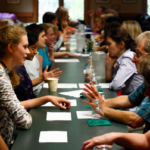This article was produced in partnership with Brown University’s TRI-Lab.
In the morning, Natalie, a student at Brown University, reads a news article about the link between immigration policies and health outcomes. She then takes the shuttle to the local hospital where she volunteers as a Health Leads advocate helping connect patients with community services and resources. After a mid-day class, Natalie reads an academic paper about language acquisition in the Journal of Pediatrics. She ends her day discussing early childhood development in Rhode Island with her team for TRI-Lab, a new collaborative research program at Brown.(a)
Natalie’s classes, reading, research, work and volunteer activities are integrated around her passion for understanding and addressing health inequalities. Her day offers a glimpse into an educational approach known as engaged scholarship. Extracurricular activities, real-world problem solving, and personal passions and interests play a central role in Natalie’s engaged education, serving as a valuable complement to the academic coursework that has traditionally been the focus of university learning.(b)
By integrating activities in and out of the classroom into a comprehensive learning experience, engaged scholarship enhances learning and better prepares students to pursue their passions and career goals after graduation. At Brown University, we recently launched an Engaged Scholars Program to explore opportunities to integrate engaged learning into the curriculum. We’re building on existing initiatives and experimenting with new ways to provide students an innovative, integrated educational experience. Here are some of the lessons we’ve learned so far.
Opportunities Beyond the Classroom Walls
Internships, entrepreneurship, volunteer opportunities, community-based research, and other extracurricular activities provide students with exposure to the world beyond campus. They can explore how to turn ideas into action, test new approaches (and sometimes fail), and learn from the complexities and complications that arise when the context shifts from a textbook or lecture to the broader community.
Community involvement engages and motivates students in exciting ways. Research shows that academic programs that incorporate civic engagement result in increased college retention and completion rates and higher student grade-point averages.2 Extracurricular learning also provides students with the knowledge, skills, and networks to launch their post-graduate careers. In a recent poll, 79% of employers said colleges should place more emphasis on applying knowledge in real-world settings.3
How can universities integrate extracurricular involvement into student education? Consider the summer internship, which has become rite of passage for many students.(c) Universities can enhance the learning potential of internships by connecting students with mentors and peers doing related work. Brown recently launched a summer program called iProv that places a small group of students in local government and non-profit organizations and gathers these students in a “learning community.” They live together in dorms, participate in weekly training sessions, and engage in informal and facilitated group reflections about their experiences.(d)
Entrepreneurship can also produce profound learning outcomes when it is designed with educational goals in mind. To foster entrepreneurship as a learning process, I launched Brown’s Social Innovation Fellowship, which gives students the funding, training, and networks to develop social ventures. In a recent internal review of the program, interviews with student fellows were evaluated using the VALUE learning assessment criteria developed by the American Association of Colleges and Universities. The review showed evidence that the program has been effective in developing students’ critical thinking, creativity, and communication skills.
Learning by Solving Problems
Part of the value of extracurricular activities is that they require students to grapple with complex, messy, “real-world” problems. This echoes a pedagogical approach known as problem-based learning (PBL), in which students are presented with complicated, cross-disciplinary problems and must acquire the knowledge to creatively solve them, often in small groups and with limited guidance from teachers. A recent review of research indicates that PBL can lead to better learning outcomes than traditional, lecture-based instruction.4
Brown has developed a number of courses that combine theory and praxis by focusing on problem-solving. In “Investing in Social Change“, students learn about the history and theory of philanthropy while engaging in the challenging practice of grantmaking. Student teams develop philanthropic strategies around topics of local importance, like immigration or healthcare access, culminating in three $20,000 grants to Providence-area non-profit agencies by the end of the semester. In the process, the students orient themselves to the local policy and service provision landscape and wrestle with questions of non-profit capacity, program evaluation, and impact. In another class, “Tools for Development: From Theory to Practice,” students learn about international development through fieldwork, guest speakers, and case studies, followed by summer volunteer projects at grassroots organizations. The emphasis on examples helps students connect theory and practice and learn to seek out the knowledge they need to address challenging problems.
Some students choose to center their entire educational experience – courses, extracurriculars, research, and other activities – around a particular problem. For Natalie, this theme is health inequalities. Another Brown student named Brett designed his curriculum around a passion for understanding and seeking solutions to climate change. He has taken courses in eight departments, including environmental studies, economics, political science, urban studies, and sociology, each offering a different but complementary lens for viewing the issue. A problem-based approach to curriculum design encourages students to break out of the boxes created by academic disciplines and pursue the diversity of knowledge they need to address complex societal challenges.
Putting the Student at the Center of Education
These new approaches to learning converge on one goal: placing students at the center of their education. The job of a university expands from molding students around a set curriculum to providing a wide selection of on- and off-campus resources that will prepare students for the careers and lives they want. Brown is a great laboratory for this type of student-driven approach because our students have been crafting their own curricular plans over four decades.(e) Our efforts now are geared towards expanding self-directed learning beyond the decision of what classes to choose from the university course catalog.
Within this framework, academic advisors play a critical role in helping students connect their studies to the world as they want to understand it. Rather than following rules that tell students what choices to make within a narrow set of options, advisors should guide students to discover their passions, talents, and interests and identify the knowledge, skills, and experience they will need to reach their goals. Then students can see their education as part of a long-term process centered on the issues and activities they care about, rather than just four years preceding their career paths.
How can universities shift from mass-produced, transactional advising focused on fulfilling course requirements to personalized guidance driven by relationships between advisors and students? One way we’ve begun to put this infrastructure in place at Brown is tapping alumni to speak on campus, advise students with similar interests, and connect students to their professional networks. This system pays off for both parties, as students receive guidance from people eager and willing to learn about them and alumni maintain deeper connections to the university through their engagement with current students.
Cultivating Engaged Scholars
At Brown, we are working to infuse opportunities for engaged scholarship throughout the undergraduate experience. Through the Engaged Scholars Program, we are expanding and integrating existing programs and experimenting with new ones to provide students with meaningful engagement with the community, experiential and problem-based learning, cross-disciplinary inquiry, and opportunities to follow their passions and interests.
Students like Natalie and programs like TRI-Lab represent a new approach to higher education. Engaged scholarship holds the potential to recharge the relevance and vitality of a liberal arts education by both inspiring students to follow their passions and equipping them with skills they can use after graduation. It can help universities fulfill their mission to both their students and society by producing graduates who think critically, act creatively, and are prepared to embark on lives of impact.(f)
This article was produced in partnership with Brown University’s TRI-Lab.
Endnotes
- Randy Bass (2012) “Disrupting Ourselves: The Problem of Learning in Higher Education,” Educause Review, March/April: 23-33.
- Christine M. Cress, Cathy Burack, Dwight E. Giles Jr., Julie Elkins, and Margaret Carnes Stevens (2010) “A Promising Connection: Increasing College Access and Success through Civic Engagement,” Boston: Campus Compact.
- Hart Research Associates (2010) “Raising the Bar: Employers’ Views on College Learning in the Wake of the Economic Downturn,” Washington, DC: Association of American Colleges and Universities.
- Andrew Walker & Heather Leary (2009) “A Problem Based Learning Meta Analysis: Differences Across Problem Types, Implementation Types, Disciplines, and Assessment Levels,” Interdisciplinary Journal of Problem-based Learning, 3(1).
Sidenotes
- (a) TRI-Lab is a Brown initiative that brings together students, professors, and representatives of community organizations to collaboratively research and test solutions to complex social problems. Natalie’s team of four students, a director of pediatrics at a local clinic, and an official from the state department of health focused on strategies to reduce the rate of missed appointments among low-income families at the clinic. The following summer, Natalie used their research to develop outreach tools to ensure that more children obtain critical health services.
- (b) A number of concepts have been used to describe similar shifts in higher education, including service learning, civic engagement, participatory research, and social innovation education. Georgetown Associate Provost Randy Bass has defined the Post-Course Era as an approach to higher education wherein formal coursework is no longer the only or primary site for learning.1
- (c) Three-quarters of American students at four-year universities complete at least one internship during their college career.
- (d) A number of valuable interactions took place during iProv’s inaugural summer. For example, a student who was collecting oral histories from families impacted by the foreclosure crisis shared ideas with a classmate working at a local non-profit advocating for affordable housing.
- (e) In 1970, Brown introduced the open curriculum, which did away with general course requirements and allowed students to craft their own curricular plans.
- (f)Brown, like many institutions of higher education, articulates a mission that extends well beyond the campus walls: “to serve the community, the nation, and the world… by educating and preparing students to discharge the offices of life with usefulness and reputation.”







